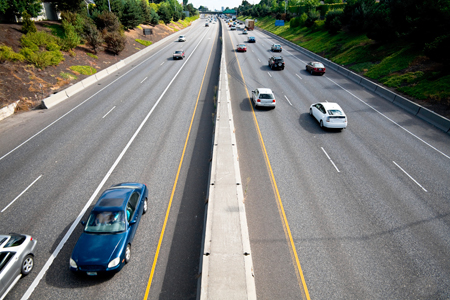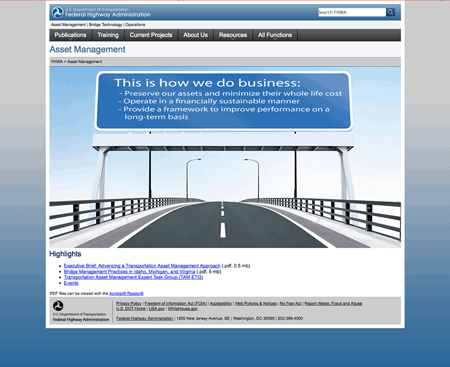U.S. Department of Transportation
Federal Highway Administration
1200 New Jersey Avenue, SE
Washington, DC 20590
202-366-4000
Focus
| Accelerating Infrastructure Innovations |
Publication Number: FHWA-HRT-13-008
Date: November 2012
Printable Version (.pdf, 0.3 mb)
How healthy is your highway infrastructure?
A new report from the Federal Highway Administration (FHWA) examines candidate methods to consistently and reliably assess infrastructure health, focusing on bridges and pavements on the Interstate Highway System. Also examined are potential tools FHWA and State departments of transportation can use to obtain key data that will provide a more complete picture of infrastructure health nationally.
Improving FHWA's Ability to Assess Highway Infrastructure Health (Pub. No. FHWA-HIF-12-049) looks at the process for categorizing bridges and pavements in good, fair, or poor condition. This begins with developing qualitative definitions for each category. For this study, the definitions relate solely to the condition of a bridge or pavement and do not consider other factors such as safety or capacity. For example, the definition of "good" used for the study was bridge and pavement infrastructure that is free of significant defects and has a condition that does not adversely affect its performance. Condition metrics and thresholds that can be used to systematically categorize assets based on these definitions should then be defined.
Building off of previous work conducted by the American Association of State Highway and Transportation Officials, three separate tiers of performance measures were evaluated. Tier 1 measures are considered ready for use at the national level, while Tier 2 measures require further work before being ready for deployment. Tier 3 measures are generally still in the proposal stage.
Performance measures for bridges included Structural Deficiency (SD) (Tier 1) and Structural Adequacy Based on National Bridge Inventory (NBI) Ratings (Tier 2). A Tier 3 measure was not included for bridges. For pavements, performance measures included the International Roughness Index (IRI) (Tier 1) and Functional Adequacy Based on Highway Performance Monitoring System (HPMS) Distress Data (Tier 2). A Tier 3 measure of Structural Condition based on Tier 2 data and pavement deflection data was also included.
The performance measures were evaluated on I-90 in Wisconsin, Minnesota, and South Dakota. This corridor runs for 1,406 km (874 mi), with average annual daily traffic ranging from approximately 5,000 vehicles to 90,000 vehicles. While about 85 percent of the corridor is rural, it links such urban areas as Madison, Wisconsin; Rochester, Minnesota; and Rapid City, South Dakota. HPMS and NBI data for this corridor were used for the study. The participating State highway agencies also provided data, including documentation of their systems, processes, and corridor inventory and pavement management system data.
The good, fair, and poor analysis for bridges proved to be a viable approach, with NBI data sufficient for the performance management assessment. However, a bridge's SD status was not as easily incorporated into the analysis. The report notes that a measure of structural adequacy based on NBI ratings would be a viable supplement to SD status as a national measure of bridge condition, although "implementation would require developing a general consensus on its definition."
The pilot study also demonstrated that the good, fair, and poor approach is feasible for pavements and implementable today using IRI as a Tier 1 measure. However, IRI does not fully represent the condition of a pavement, as it indicates little about the ability of the pavement structure to withstand traffic loadings. Implementation of the Tiers 2 and 3 pavement measures also proved to be feasible, although the study recommends data collection and processing improvements to advance the measures and achieve a more accurate picture of pavement health.
For example, collection of cracking data needs to be better defined, along with recommended quality control and quality assurance standards. Inconsistencies in collection and analysis of faulting data should also be resolved. The study suggests using FHWA's ProVAL software tool to analyze faulting may be a suitable first step in addressing these inconsistencies and standardizing analysis of faulting data. ProVAL assists users in analyzing longitudinal pavement profiles.
The recommended next step in bridge assessment is for FHWA to develop a new measure of structural adequacy based on NBI ratings. This new measure could serve as an eventual supplement to SD as a national measure of bridge condition. In developing the new measure, two questions should be discussed:
For pavements, the next steps include completing and implementing the good, fair, and poor indicator based on IRI data. Incorporation of additional selected distresses into the indicator should also be studied. These could include cracking and rutting in asphalt pavements and cracking and faulting in concrete pavements. FHWA's Pavement Health Track Analysis Tool should also be improved so that it can provide a more comprehensive measure of pavement condition. This tool can help determine the health of a pavement network in terms of the pavement's remaining service life.
The report recommends that FHWA consider developing a tool to automate creation of an infrastructure health report. This tool would enable users to select a corridor or network and view its condition. The tool should also allow users to incorporate the required HPMS and NBI data directly into the report. A prototype is discussed.
To download Improving FHWA's Ability to Assess Highway Infrastructure Health, visit www.fhwa.dot.gov/asset/pubs/hif12049/hif12049.pdf. For more information on the report, contact Nastaran Saadatmand at FHWA, 202-366-1337 (email: nastaran.saadatmand@dot.gov).

Improving FHWA's Ability to Assess Highway Infrastructure Health looks at methods for consistently and reliably evaluating the health of bridges and pavements. (Photo Credit: © www.iStockphoto.com/Daniel Deitschel)

To learn more about the new report on Improving FHWA's Ability to Assess Highway Infrastructure Health or other asset management resources, visit www.fhwa.dot.gov/asset.